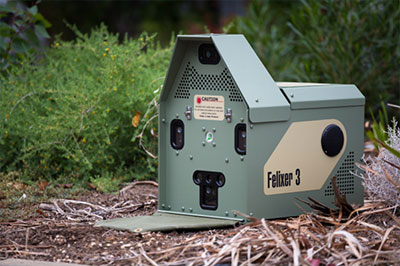Notice for the Island - Article: New free-roaming cat control measures to be introduced
24 January 2024

Norfolk Island National Park has been working on solutions to control free-roaming cat populations in the park. Without critical controls in place, cat numbers are likely to increase and become an even greater threat to our native wildlife, much of which is vulnerable or threatened.
In 2019, a network of 90 strategically-placed cameras were deployed around the island. Based on data captured using these cameras it was estimated there were around 100 free-roaming cats on the Island at any given time. Over recent years, both the local council and the national park have intensified trapping initiatives, resulting in the capture of 429 cats from 2019 to 2022.
Despite these efforts, cat activity in the national park remains unacceptably high. The park aims to reduce cat activity to less than 50 per cent of our monitored sites. To achieve this, it has become clear we need to trial new technology to target free roaming cats.
The Felixer has been designed as a novel, humane and automated tool to control free-roaming cats. Using rangefinder sensors to distinguish cats from other non-target animals and humans, the Felixer sprays a toxin onto detected cats, which is ingested as the cat grooms itself.
The Felixer has been extensively tested in Australia, particularly in unique island ecosystems. It has been shown to be highly specific in targeting cats while limiting impacts on other species. You can read more about the Felixer by visiting https://thylation.com/felixer-faqs/.
Norfolk Island National Park is set to begin a three-month non-toxic trial of 3 Felixer machines in February. No toxins will be used during these trials. The trial will aim to:
Confirm target accuracy: The Felixers are designed to photograph all animals they detect, including non-target species. Results from the trial will be closely analysed to ensure there haven’t been any species identification errors.
Confirm suitability for Norfolk Island: At the locations where Felixers are deployed, the park will also deploy traditional cage traps and cameras to test whether the Felixer is a more efficient and effective method of controlling free roaming cats. The Felixers will be placed deep within the park on remote rodent bait station lines, away from park boundaries and walking tracks.
Keep the community informed: The park will communicate with the community when the Felixers are in operation, and will engage the community to discuss feedback and results at the end of the trial. We are committed to working together with the community to manage the impact of cats on the island’s unique native species.
During the trial phase, community members who are concerned about their domestic cat entering the national park can request access to specialised Bluetooth collars. When the Felixer detects this collar within a 20m radius, this data is logged, but the Felixer will not activate. The non-toxic trial phase will allow the national park to test the suitability of these collars for our unique environment and conditions.
Upon completion of the non-toxic trial, the Felixer units will be returned to Australia and Norfolk Island National Park will hold a community forum to discuss the results of the trial and consider, with the community’s input, the next steps.
In the meantime, if you have any comments about the trial, or would like some more information, please reach out to the National Park team by calling 22695, or emailing us at norfolkislandnationalpark@dcceew.gov.au.